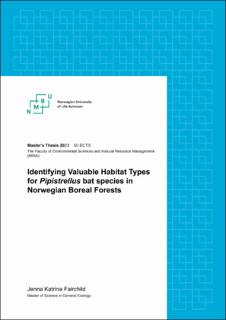| dc.description.abstract | * Bats are a substantial component of the forest vertebrate community and provide numerous ecosystem services. Although protected in Norway, bats still face threats to their habitat due to intensive forestry but are rarely considered in forest management plans. Generally, little is known about bat-habitat relationships in Fennoscandian boreal forests, and scientific studies from Norway are particularly scarce. Pipistrellus species are especially interesting in regard to their habitat use, as although classified as edge-space foragers, they display substantial echolocation plasticity, meaning that they are able to hunt and manoeuvre in both cluttered environments and open spaces.
* The goal of this study was to explore characteristics of habitat more highly selected by Pipistrellus spp. bats within Norwegian boreal forests. It examines; (1) whether the amount of Pipistrellus spp. acoustic activity, i.e., commuting, feeding, and social behaviour, varies between different boreal forest sub-habitats, and (2) how Pipistrellus spp. activity i.e., commuting, feeding and social behaviour, is influenced by forest stand density.
* Data was collected at 12 boreal forest sites in south-eastern Norway during May and June 2021. Sites were classified as “mixed” coniferous-deciduous forests and were located along a forest density gradient. Pipistrellus spp. activity was assessed through non-invasive monitoring using acoustic bat detectors, and passes were manually analysed to identify species and behaviour (feeding, commuting, and social). Activity was compared between three different sub-habitats: (1) forest gaps and (2) interior forest at ground-level, and in the (3) forest canopy. Stand level forest density was measured using the total number of stems as a proxy.
* Among the monitored sites, there was substantial variation in levels of Pipistrellus spp. acoustic activity, and across all sites, P. pygmaeus was the dominant species identified. Forest gaps displayed the highest amount of both feeding, and social behaviour, whilst the forest interior displayed the least. All habitats displayed low levels of social behaviour. Forest density was negatively correlated with commuting and feeding passes in both forest gaps and the forest interior, although an apparent positive correlation was displayed in the forest canopy.
* The findings of this study indicate that boreal forests with a more natural dynamic, which contain gaps and a more heterogenic structure, are more valuable habitat for Norway’s Pipistrellus spp. than dense, homogenous forest stands. This has implications for future bat conservation decisions in both Norway and other Nordic countries, particularly in regard to forest management practices. Increasing the number of forest gaps, whilst managing and maintaining those that already exist, will likely greatly benefit Pipistrellus spp. populations. | |
